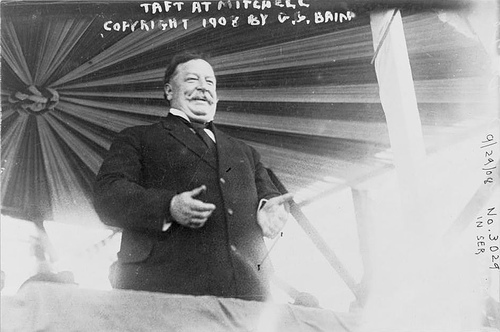17 + 77 + 47 + 17 + 77 + 27 + 57 = 1741725
Author: Greg Ross
Bills of Lading
Devised by Lee Sallows, each of these lists inventories its own contents:
- fifteen e’s, seven f’s, four g’s, six h’s, eight i’s, four n’s, five o’s, six r’s, eighteen s’s, eight t’s, four u’s, three v’s, two w’s, three x’s
- sixteen e’s, five f’s, three g’s, six h’s, nine i’s, five n’s, four o’s, six r’s, eighteen s’s, eight t’s, three u’s, three v’s, two w’s, four x’s
All Aboard

William Howard Taft once found himself stranded at a country railroad station and was told that the express train would not stop for a lone passenger.
He wired the conductor: STOP AT HICKSVILLE. LARGE PARTY WAITING TO CATCH TRAIN.
When the train stopped, Taft got aboard and told the conductor, “You can go ahead. I am the large party.”
Paradoxical Undressing
Hypothermia victims are often found with clothing removed, as if they’ve been assaulted. It’s not clear why a freezing person would undress; possibly their judgment is impaired, and possibly exhaustion brings a sensation of warmth to the skin.
“A Rare Circle of Friends”
Sir Henry Blackman, of Lewes, on being knighted in 1782, gave a dinner to sixteen friends, with an invitation to them to dine with him annually for forty years; four of them died during the first four years, but twenty-eight years rolled round before another seat became vacant at the festive board. In 1814 two died, aged between eighty and ninety; so that ten remained of the original number at the thirty-third anniversary, held in July, 1815!
— Curiosities for the Ingenious, 1825
Subtraction Pangram
Each term in this equation contains each of the nine digits once:

Careful!
Before conductors used batons, they kept time by banging a long staff against the floor. In January 1687, Jean-Baptiste Lully was conducting a Te Deum in this way when he struck his toe. The wound turned gangrenous, the gangrene spread — and he died.
Letter Shift

Mind Your Money
A cold coin placed on the forehead feels heavier than a warm one.
An Alarming Paradox
In 1735, an anonymous “lover of mathematicks” offered the following conundrum:
“‘Tis certainly Matter of Fact, that three certain Travellers went on a Journey, in which, tho’ their Heads travelled full twelve Yards more than their Feet, yet they all return’d alive, with their Heads on.”
How is this possible?
